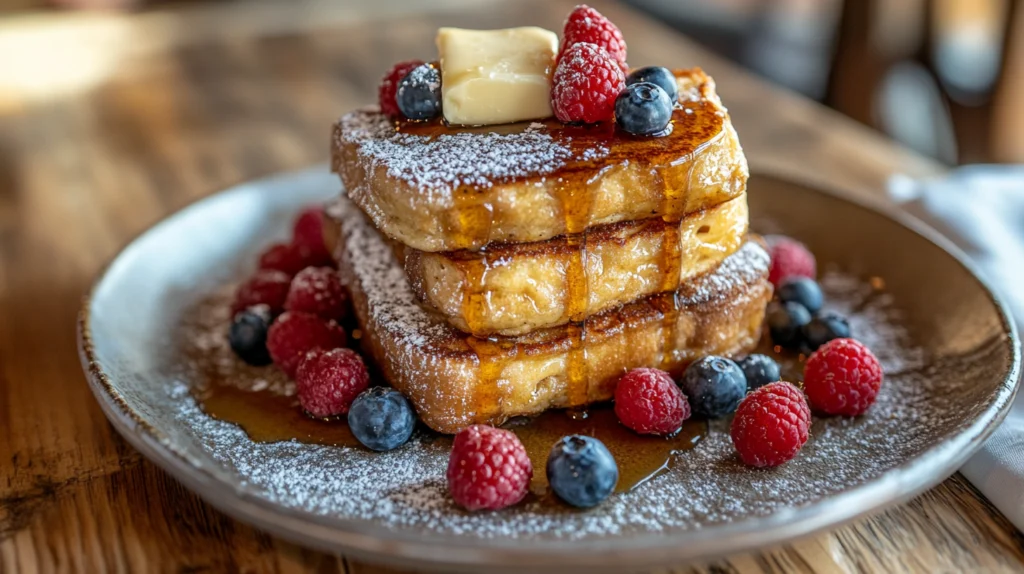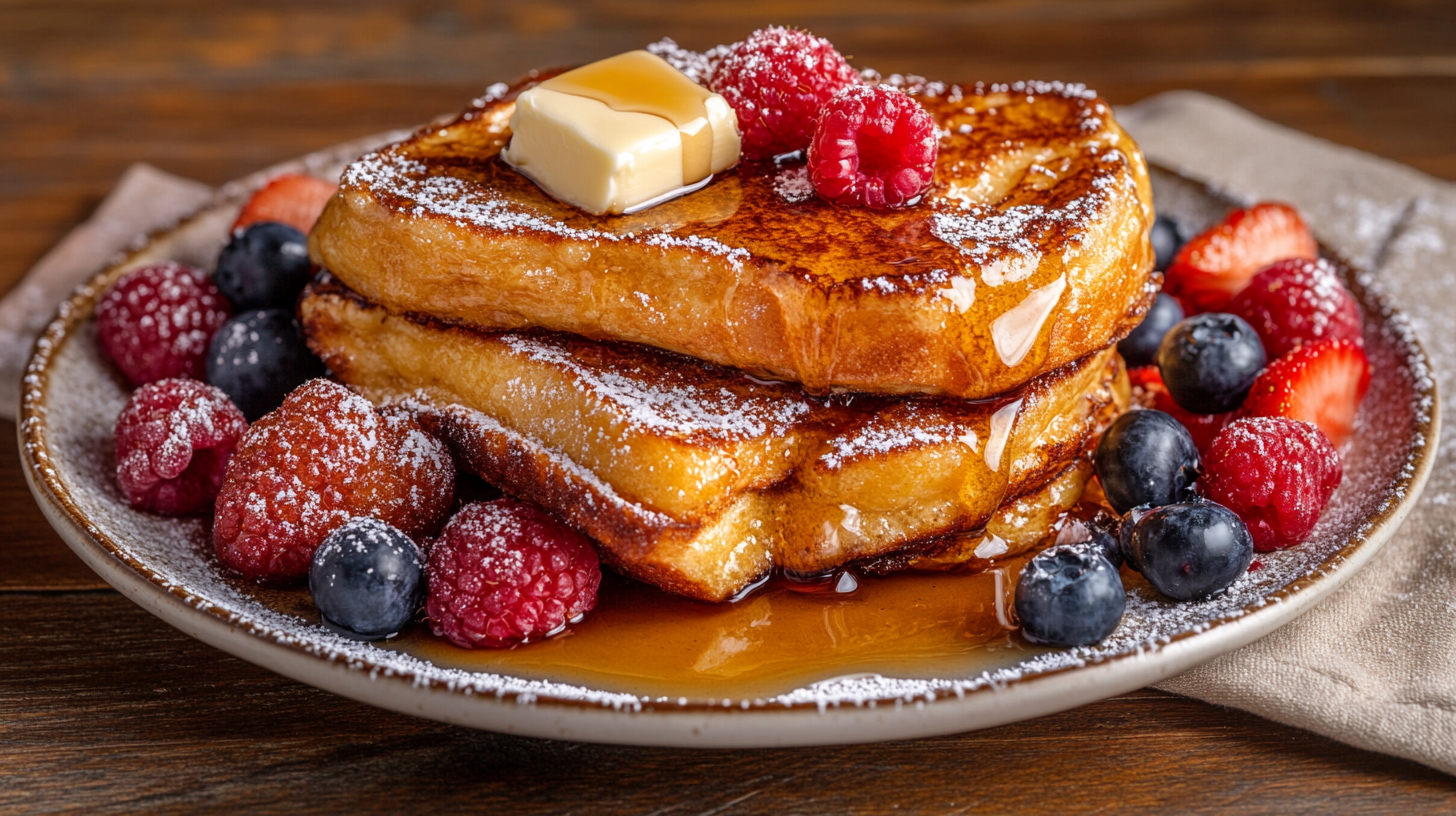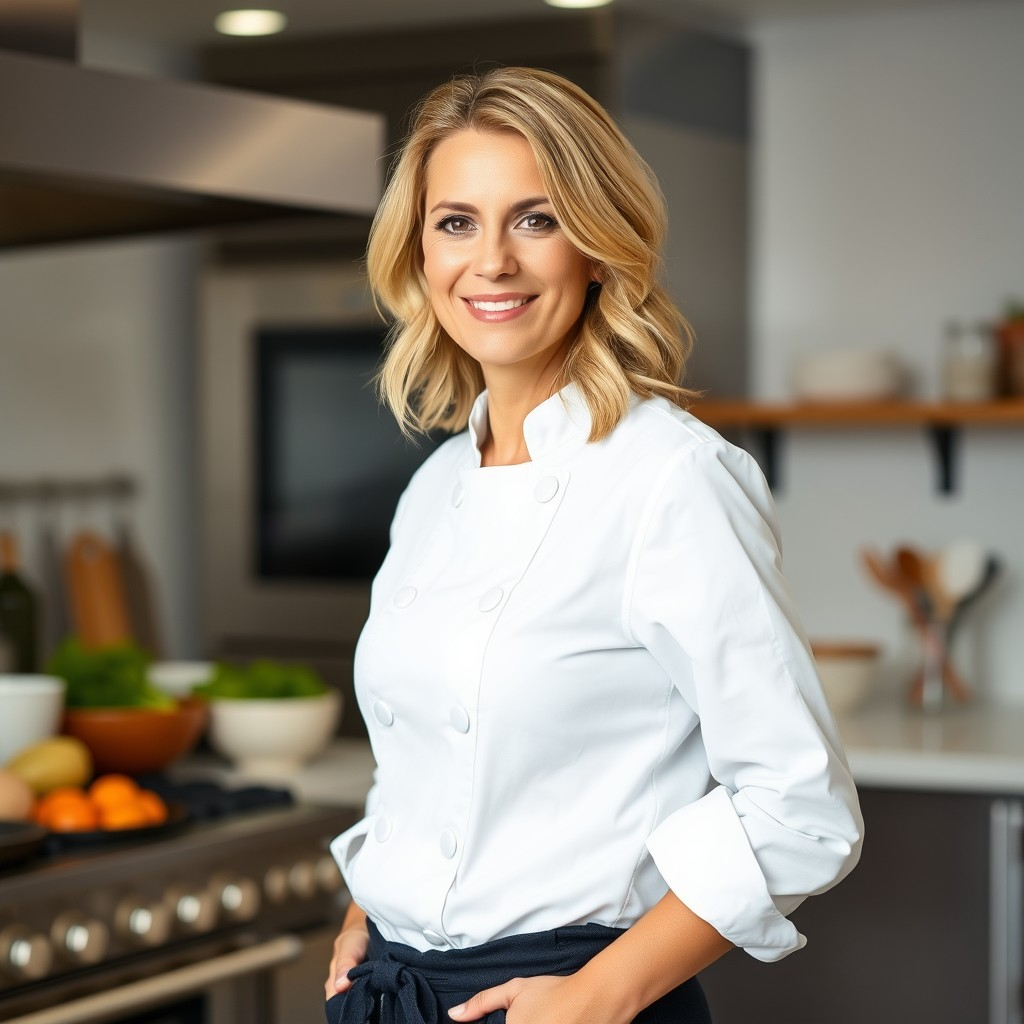French toast pancakes combine the best of two beloved breakfast dishes into one delectable creation. These are a fusion of the soft, custard-soaked bread of French toast with the light, fluffy texture of pancakes. They’re easy to make, quick to cook, and perfect for weekend mornings or special breakfasts. Whether you’re a seasoned cook or a beginner, mastering this dish is entirely achievable with a few key steps.
The magic begins with preparing a batter that blends traditional pancake ingredients with a hint of French toast flavor. Cooking them to perfection requires just the right amount of heat and attention to timing. Once you’ve prepared the base, the fun begins with choosing toppings, like syrup, fruits, or even whipped cream.
French toast pancakes are a breakfast favorite, just like Scrambled Pancakes. Both are simple, versatile, and perfect for trying new toppings!
Table of Contents
Essential Ingredients
To create the perfect French toast pancakes, you’ll need just a few staple ingredients commonly found in most kitchens. These include:
- All-purpose flour for the pancake base.
- Milk or a non-dairy alternative for the liquid component.
- Eggs to bind the mixture and replicate the custardy essence of French toast.
- Sugar to add just the right hint of sweetness.
- Cinnamon and vanilla extract for flavor.
Each ingredient plays a crucial role in achieving the right balance of flavor and texture. While all-purpose flour provides structure, milk ensures a moist and tender consistency. The cinnamon and vanilla infuse the batter with a warm, aromatic taste reminiscent of traditional French toast. These essentials are easy to adjust, allowing you to tailor the recipe to your preferences or dietary needs.
Step-by-Step Guide to Preparing the Batter
Creating the perfect batter for French toast pancakes is straightforward if you follow a few simple steps. Start by whisking the dry ingredients—flour, sugar, baking powder, and a pinch of salt—in a large mixing bowl. This ensures they’re evenly distributed.
In another bowl, combine the wet ingredients. Beat the eggs first, then add milk and vanilla extract. Pour this mixture into the dry ingredients, stirring just until combined. Overmixing can make your pancakes dense, so a few lumps are okay.
For a French toast twist, sprinkle cinnamon into the batter. The result should be slightly thicker than traditional pancake batter but still pourable. This batter can be prepared in advance and stored in the refrigerator, saving time on busy mornings.
Cooking Techniques for Perfectly Fluffy French Toast Pancakes
Achieving fluffy French toast pancakes requires precision and patience. Start by preheating a non-stick skillet or griddle over medium heat. Lightly grease it with butter or cooking spray to prevent sticking.
Spoon the batter onto the heated surface, using about ¼ cup for each pancake. Cook until bubbles form on the surface and the edges appear set. This typically takes about 2–3 minutes. Flip the pancake gently and cook the other side for an additional minute or two.
Maintaining an even temperature is critical; too high, and the pancakes will brown too quickly without cooking through.
Choosing the Right Bread for French Toast Pancakes
The bread you select can greatly influence the outcome of your French toast pancakes. While pancake batter is the base, incorporating bread into the recipe adds a unique texture and flavor. Classic choices include brioche, challah, or even thick slices of Texas toast.
These breads absorb the batter beautifully while retaining their structure during cooking. Avoid thin or overly delicate breads, as they may disintegrate. Day-old bread often works best since it’s firmer and less likely to become soggy.
If you prefer a more rustic texture, experiment with sourdough or multigrain options. Regardless of the choice, ensuring the bread is evenly soaked in the batter will yield the best results for a memorable French toast pancake experience.

Toppings and Garnishes
The right toppings can transform your French toast pancakes into a breakfast masterpiece. Classic options include maple syrup, powdered sugar, and fresh berries. For a more indulgent touch, add a dollop of whipped cream or a drizzle of caramel sauce.
Savory toppings can also work well. Try a pat of salted butter with a sprinkle of herbs or crispy bacon on the side for a balanced flavor profile.
For added texture, consider:
- Chopped nuts like pecans or walnuts.
- Shredded coconut for a tropical twist.
- Chocolate chips for a sweet treat.
These toppings not only complement the flavor but also create a visually appealing dish that’s sure to impress your guests.
Creative Flavor Variations
Experimenting with flavors can take your French toast pancakes to the next level. For a fruity twist, fold mashed bananas or blueberries into the batter. If you love spices, try adding nutmeg or cardamom alongside the cinnamon.
For a dessert-inspired variation, mix cocoa powder into the batter and top the pancakes with chocolate sauce and strawberries. Alternatively, add a splash of flavored extracts like almond or hazelnut for a unique taste.
Savory options can include cheese or finely chopped herbs. The versatility of this dish allows endless possibilities, ensuring there’s a version of French toast pancakes to suit every palate and occasion.
Tips for Serving French Toast Pancakes to Guests
Serving French toast pancakes to guests requires a touch of creativity and preparation. To ensure they remain warm and fresh, place cooked pancakes on a baking sheet in a low oven (around 200°F) until ready to serve.
Arrange the pancakes on a platter and provide a selection of toppings in small bowls, allowing guests to customize their breakfast. Adding a garnish, such as a sprig of mint or a dusting of cinnamon, enhances the presentation.
For a memorable breakfast experience, consider pairing French toast pancakes with fresh-squeezed orange juice or a robust cup of coffee. With thoughtful preparation and presentation, your guests are sure to leave impressed and satisfied.
How to Store and Reheat French Toast Pancakes
Properly storing and reheating French toast pancakes ensures they remain delicious and fresh. To store them, let the pancakes cool completely before placing them in an airtight container. If you plan to eat them within a day or two, keep them in the refrigerator. For longer storage, freeze the pancakes by separating them with parchment paper to prevent sticking.
Reheating is simple and effective when done correctly. Use a microwave for a quick option, reheating in short intervals to avoid overcooking. Alternatively, warm them in an oven at 300°F for a few minutes, which helps retain their texture. For the best results, use a skillet to reheat them over low heat, ensuring a slightly crispy exterior.
Vegan and Gluten-Free French Toast Pancakes Alternatives
Creating vegan and gluten-free French toast pancakes is easier than you might think. For a vegan version, replace eggs with flaxseed or chia seed gel and use plant-based milk like almond or oat milk. Coconut oil or vegan butter works wonderfully in place of dairy butter.
For gluten-free options, swap all-purpose flour with gluten-free flour blends or almond flour. Adding a pinch of xanthan gum can improve the texture for gluten-free batters. Keep in mind that certain gluten-free flours may require more liquid, so adjust accordingly.
Seasonal French Toast Pancakes Ideas for Every Occasion
French toast pancakes can easily be tailored to fit any season or occasion. For spring, infuse the batter with lemon zest and top with fresh berries. In summer, consider a tropical theme with shredded coconut, pineapple chunks, and a drizzle of coconut syrup.
During fall, pumpkin spice French toast pancakes with a hint of nutmeg and cloves are a crowd-pleaser. For winter, add a touch of cocoa powder to the batter and serve with peppermint whipped cream.
Seasonal themes can extend to toppings as well, such as apple compote in autumn or candied citrus in winter. These variations not only reflect the time of year but also provide an exciting twist on the classic recipe.
Common Mistakes to Avoid
Avoiding common mistakes can make all the difference in achieving perfect French toast pancakes. One frequent error is overmixing the batter, which can lead to dense pancakes. Mixing just until combined is key.
Cooking at too high a temperature is another issue, as it causes the pancakes to brown on the outside while remaining undercooked inside. Medium heat is ideal. Additionally, using fresh bread that is too soft may result in soggy pancakes. Opt for day-old or slightly stale bread for better results.
Finally, skipping the resting step after preparing the batter can hinder the fluffiness. Allowing the batter to rest for a few minutes helps create light and airy pancakes.
Pairing French Toast Pancakes with Beverages
Pairing French toast pancakes with the right beverages elevates the breakfast experience. Classic options include freshly brewed coffee or a frothy cappuccino, which complement the sweet and rich flavors.
For a non-caffeinated option, freshly squeezed orange juice or apple cider works beautifully. If you’re serving them for a special brunch, a sparkling mimosa adds a festive touch.
For children, warm cocoa or a glass of milk makes a delightful pairing. Matching the pancakes with the perfect beverage not only enhances the flavors but also creates a well-rounded meal that everyone will enjoy.
A Brief History of French Toast Pancakes
French toast pancakes are a modern twist on two classic breakfast dishes with deep-rooted histories. French toast, believed to date back to ancient Rome, was initially created as a way to use up stale bread. Pancakes, on the other hand, have been a staple across cultures for centuries, with recipes varying globally.
The idea to combine the custard-like richness of French toast with the fluffy lightness of pancakes likely stemmed from a love for both dishes. Though rooted in simplicity, this fusion has grown in popularity, offering a creative and indulgent option for breakfast enthusiasts seeking something unique yet comforting.
French Toast Pancakes Around the World
While French toast pancakes are a uniquely modern creation, variations of similar dishes exist globally. In France, pain perdu, a form of French toast, is commonly enjoyed with jam or syrup. Pancakes, meanwhile, appear in numerous cultures, from American-style buttermilk pancakes to Japanese soufflé pancakes.
Countries like India and Brazil have their own breakfast recipes that incorporate spiced batters and diverse toppings, offering a parallel to French toast pancakes. This global appreciation for inventive breakfast dishes highlights how food transcends cultural boundaries and inspires new culinary creations.
Kid-Friendly French Toast Pancakes Recipes
French toast pancakes are a hit with kids, especially when tailored to their tastes. Adding chocolate chips or rainbow sprinkles to the batter can make breakfast more exciting. Serving the pancakes in fun shapes using cookie cutters is another way to delight younger eaters.
Toppings like whipped cream, colorful fruits, or even a drizzle of chocolate syrup turn breakfast into a treat. You can also involve kids in the process, letting them choose their toppings or help with mixing the batter.
Using Leftovers: Transforming French Toast Pancakes into New Dishes
Leftover French toast pancakes don’t have to go to waste. Transform them into creative dishes to enjoy later. For a sweet option, layer the pancakes with yogurt and fruit to create a quick breakfast parfait. You can also cut them into strips and bake them for a crunchy snack.
For a savory twist, use the pancakes as a base for open-faced sandwiches or breakfast sliders. Leftovers can even be diced and added to bread pudding for a unique dessert.
FAQs
What do French people call American pancakes?
In France, American pancakes are commonly referred to as pancakes américains. This term distinguishes them from French crêpes, which are thinner and more delicate. American pancakes are recognized for their fluffy texture and smaller size compared to the traditional crêpe, making them a unique breakfast item enjoyed in their own way.
How long should French toast soak?
French toast should soak for about 15–30 seconds per side in the custard mixture. This ensures the bread absorbs enough liquid to become flavorful and moist without becoming overly soggy. The soaking time may vary depending on the type and thickness of the bread used. Denser breads, like brioche or challah, can handle a longer soak compared to lighter, thinner breads.
What is the trick to French toast?
The key to perfect French toast lies in balancing the batter, heat, and bread. Use slightly stale bread to prevent sogginess and ensure even absorption. Whisk the batter thoroughly so the flavors are well blended, and cook the bread over medium heat to allow the interior to cook while achieving a golden, crispy exterior. Adding a pinch of salt enhances the sweetness, making every bite flavorful.
Are pancakes and French toast the same?
No, both are not the same, though they’re both popular breakfast dishes. Pancakes are made from a liquid batter poured onto a griddle and cooked until fluffy. French toast, on the other hand, is made by soaking slices of bread in a custard mixture and then frying them. While their ingredients overlap, the preparation and texture are distinct, making each dish uniquely enjoyable.
Conclusion
French toast pancakes are a versatile and delightful breakfast choice that combines the best of two iconic dishes. From selecting the right ingredients to exploring creative flavors and variations, there’s no limit to how you can enjoy this classic fusion. With proper storage, innovative ideas for leftovers, and pairing them with complementary beverages, French toast pancakes become more than just a meal—they’re a memorable experience. Whether you’re serving family, impressing guests, or experimenting with seasonal twists, this dish will always be a crowd-pleaser on any breakfast table.


